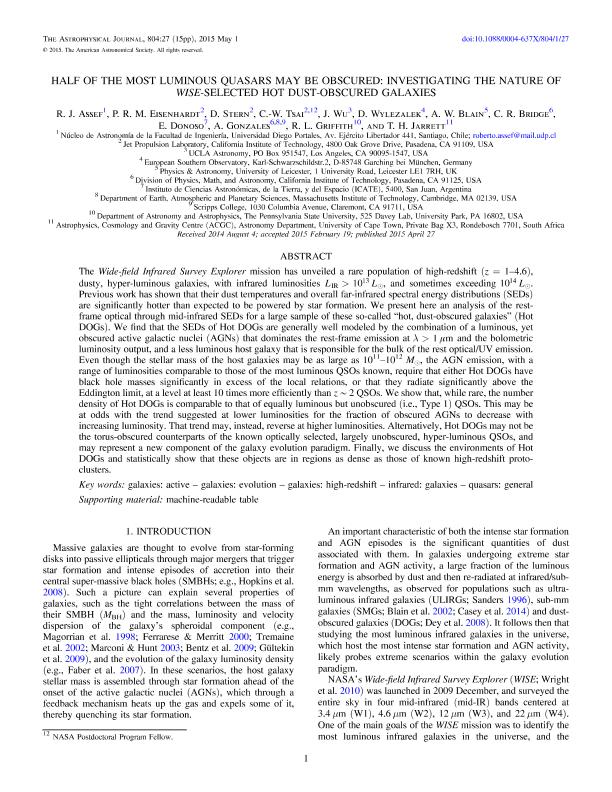Artículo
Half of the Most Luminous Quasars May Be Obscured: Investigating The Nature Of WISE-Selected Hot Dust-Obscured Galaxies
Assef, R. J.; Eisenhardt, P. R. M.; Stern, D.; Tsai, Chao Wei; Wu, Jingwen; Wylezalek, D.; Blain, A. W.; Bridge, C.; Donoso, Emilio ; Gonzales, A.; Griffith, R. l.; Jarrett, T. H.
; Gonzales, A.; Griffith, R. l.; Jarrett, T. H.
 ; Gonzales, A.; Griffith, R. l.; Jarrett, T. H.
; Gonzales, A.; Griffith, R. l.; Jarrett, T. H.
Fecha de publicación:
05/2015
Editorial:
IOP Publishing
Revista:
Astrophysical Journal
ISSN:
0004-637X
Idioma:
Inglés
Tipo de recurso:
Artículo publicado
Clasificación temática:
Resumen
The Wide-field Infrared Survey Explorer mission has unveiled a rare population of high-redshift (z = 1–4.6), dusty, hyper-luminous galaxies, with infrared luminosities LIR > 10 L 13 , and sometimes exceeding 10 L 14 . Previous work has shown that their dust temperatures and overall far-infrared spectral energy distributions (SEDs) are significantly hotter than expected to be powered by star formation. We present here an analysis of the restframe optical through mid-infrared SEDs for a large sample of these so-called “hot, dust-obscured galaxies” (Hot DOGs). We find that the SEDs of Hot DOGs are generally well modeled by the combination of a luminous, yet obscured active galactic nuclei (AGNs) that dominates the rest-frame emission at l > 1 μm and the bolometric luminosity output, and a less luminous host galaxy that is responsible for the bulk of the rest optical/UV emission. Even though the stellar mass of the host galaxies may be as large as 1011–1012 Me, the AGN emission, with a range of luminosities comparable to those of the most luminous QSOs known, require that either Hot DOGs have black hole masses significantly in excess of the local relations, or that they radiate significantly above the Eddington limit, at a level at least 10 times more efficiently than z ∼ 2 QSOs. We show that, while rare, the number density of Hot DOGs is comparable to that of equally luminous but unobscured (i.e., Type 1) QSOs. This may be at odds with the trend suggested at lower luminosities for the fraction of obscured AGNs to decrease with increasing luminosity. That trend may, instead, reverse at higher luminosities. Alternatively, Hot DOGs may not be the torus-obscured counterparts of the known optically selected, largely unobscured, hyper-luminous QSOs, and may represent a new component of the galaxy evolution paradigm. Finally, we discuss the environments of Hot DOGs and statistically show that these objects are in regions as dense as those of known high-redshift protoclusters.
Palabras clave:
Galaxies
,
Infrared
,
Quasars
Archivos asociados
Licencia
Identificadores
Colecciones
Articulos(ICATE)
Articulos de INST.D/CS ASTRONOMICAS D/LA TIERRA Y DEL ESPACIO
Articulos de INST.D/CS ASTRONOMICAS D/LA TIERRA Y DEL ESPACIO
Citación
Assef, R. J.; Eisenhardt, P. R. M.; Stern, D.; Tsai, Chao Wei; Wu, Jingwen; et al.; Half of the Most Luminous Quasars May Be Obscured: Investigating The Nature Of WISE-Selected Hot Dust-Obscured Galaxies; IOP Publishing; Astrophysical Journal; 804; 1; 5-2015; 1-15
Compartir
Altmétricas



